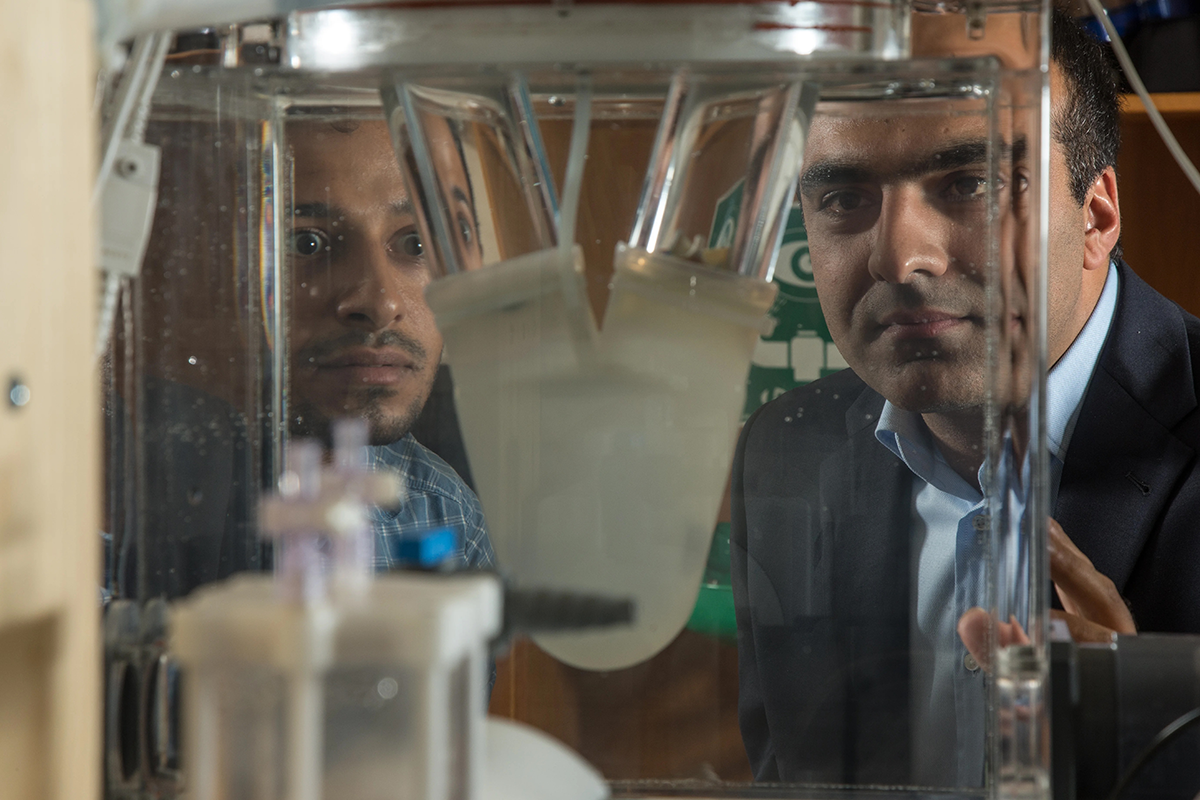Q&A: Ritchie School Researcher Combatting Heart Disease

Valentine’s Day is here and hearts are all around. But Feb. 14 is not the only day you should be thinking about hearts. February is American Heart Month, dedicated to raising awareness about cardiovascular health and heart disease—the leading cause of death among Americans, according to the Centers for Disease Control and Prevention.
For a group of researchers in the Ritchie School of Engineering and Computer Science, understanding heart disease is a year-round commitment. Ali Azadani, associate professor and director of the DU Cardiovascular Biomechanics Lab, and his colleagues are working to develop new and innovative treatments and cardiovascular implants that could improve the health and lives of millions of Americans and people across the globe.
In an interview with the DU Newsroom, Azadani weighed in on the need for cardiovascular research and the impact that novel treatments and technologies may provide. This conversation has been edited for clarity.
Why is heart disease such an important area of research?
Cardiovascular diseases affect millions of people in the United States and worldwide, posing a substantial public health challenge. These diseases are multifactorial disorders, emphasizing the need to enhance our understanding and provide more efficient treatment options. While significant improvements have occurred in the past few decades, the potential for more effective and safer treatments exists today, thanks to advanced technologies and engineering tools.
What are the biggest challenges in developing therapies or other interventions to reduce the impacts of heart disease?
Developing therapies and interventions for treating cardiovascular diseases is intricate and involves multiple components. Heart diseases encompass a broad spectrum, with unique challenges for each disease and individual patient. The complexity of these diseases makes it challenging to identify a one-size-fits-all solution.
Patients also vary in their responses to treatments. While customizing treatments based on the unique characteristics of each patient is a goal, implementing this on a large scale is challenging. In addition, developing and implementing new therapies can be costly, impacting their accessibility to a broader population. Therefore, ensuring the affordability and availability of effective interventions remains a significant challenge.
How does your work help individual patients?
Since 2013, our lab has focused on applied and translational research in cardiovascular engineering. Our research projects look at various aspects of structural heart disease, including developing patient-specific therapeutic strategies and transcatheter heart valve replacement. We have expertise in computational modeling and simulation techniques, and we have access to state-of-the-art equipment.
These resources enable us to conduct comprehensive and detailed analyses of cardiovascular structures and blood flow dynamics — and to develop patient-specific simulations to study a variety of clinical scenarios. Incorporating these models into clinical practice could improve our understanding of the underlying mechanisms.
What is the role of technology in patient-specific care for heart disease?
The engineering tools we have in the lab allow us to explore the performance of cardiovascular devices, such as transcatheter heart valves or blood pumps, in different scenarios. In designing new treatments and medical devices, it is essential to identify, analyze and mitigate various risks. It’s typical to concentrate on the most frequently encountered use scenarios linked to a specific treatment or medical device; however, it’s imperative to consider the broadest range of potential worst-case scenarios. Utilizing these tools, we can extend our capabilities to tailor interventions and treatments according to individual needs.
One of your ongoing projects involves developing a prototype implantable heart pump for patients with heart failure with preserved ejection fraction (HFpEF). Could you explain what HRpEF is and how the implant could impact patients’ lives?
Heart failure is characterized by the heart muscle's inability to pump sufficient blood to meet the body's oxygen and nutrition requirements. When the heart functions normally but lacks flexibility in filling properly, it is referred to as heart failure with preserved ejection fraction (HFpEF). HFpEF occurs due to chronic medical conditions such as obesity, hypertension and diabetes. Common symptoms of HFpEF include shortness of breath during physical activity or at rest, fatigue, chest discomfort and swelling in the lower extremities.
HFpEF affects over 33 million people in the developed world, with approximately 3.1 million Americans being impacted. Due to an aging population, the prevalence of HFpEF is anticipated to rise by nearly 50% within the next decade. Because no effective therapy has been established as a standard, there has been a movement to develop and evaluate device-based therapies.
We are working with Cardiost, a startup company based in Denver, to develop a Left Atrium Unloading Device (LAUD). The LAUD is a fully implantable system with a heart assist pump that suctions blood from the left atrium and injects it into the descending aorta, reducing left atrium pressure and increasing cardiac output. The long-term goal is to commercialize the device, as no such treatment is currently available. The Colorado Office of Economic Development and International Trade is supporting the project.
What would you like the DU community to know about the work of the DU Cardiovascular Biomechanics Lab?
DU has recently attained a Research 1 (R1) classification, and biomechanics is a strategic initiative at the Ritchie School of Engineering and Computer Science — which aligns with our lab’s expertise and research interests l. This enables us to make meaningful contributions to ongoing initiatives and collaborate with like-minded professionals.
We embrace the philosophy, "To achieve all that is possible, we must attempt the impossible." This principle inspires us to boldly explore new frontiers and continuously strive for excellence in our research endeavors in cardiovascular biomechanics. Over the past decade, I have been dedicated to advising and mentoring undergraduate students, graduate students and postdoctoral fellows, nurturing their growth and development. Our research pursuits have yielded exciting results and innovations. I encourage interested students to contact me directly to learn about ongoing research projects.








